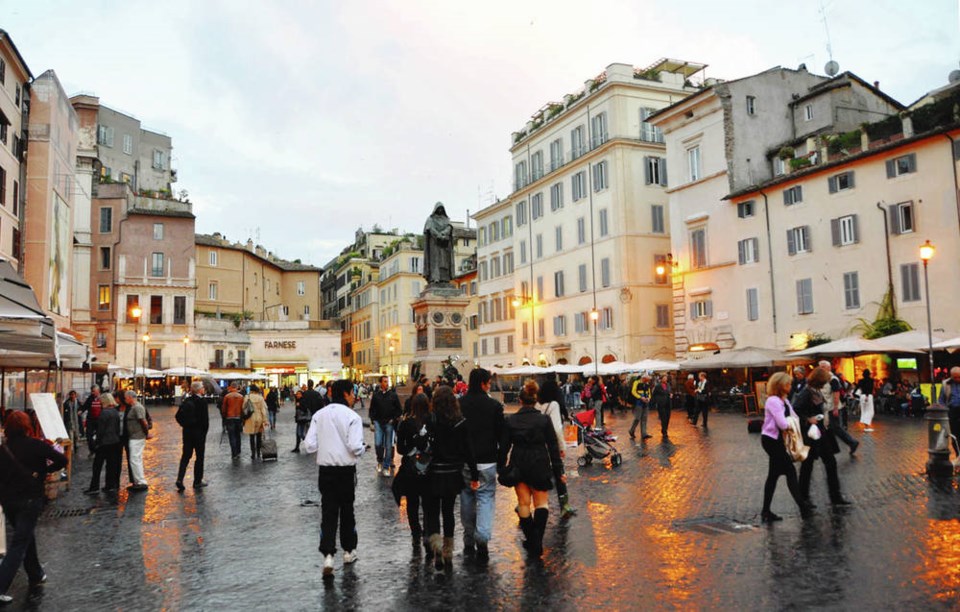Until European travel becomes fully open to North Americans, hereŌĆÖs a reminder of the fun that awaits in Europe.
A statue of Giordano Bruno marks the centre of Campo deŌĆÖ Fiori ŌĆö my favorite square in Rome. Five centuries ago, Bruno challenged the Roman Church and was burned at the stake right here. With each visit, I make a quiet little pilgrimage, staring into the eyes of brooding Bruno, pondering the courage of those early heretics.
When in Rome, I use Bruno as a meeting point. (I like to say, ŌĆ£IŌĆÖll be sitting under Bruno.ŌĆØ) Tonight, IŌĆÖm waiting for my Roman friends Stefano and Paola. With each visit, they take me on a quest for restaurants to recommend in my guidebook. TheyŌĆÖve promised to take me to a little restaurant they deem perfect. When they arrive, I say ciao to Bruno and we walk down a narrow cobbled lane to a classic, crumpled little piazza filled with scooters. On the far side, a single eatery is all lit up. The sign above the door says ŌĆ£Filetti di Baccal├Ā.ŌĆØ
ŌĆ£Stefano, youŌĆÖre right. This is perfect.ŌĆØ I walk ahead, navigating the gridlock of abandoned scooters to get into the restaurant. A long line of tables, covered with white-paper tablecloths and crowded with locals, stretches to a neon-lit kitchen in the back. And there, two grease-splattered cooks are busy cranking out filetti di baccal├ĀŌĆ”RomeŌĆÖs answer to fish sticks.
ThereŌĆÖs one table open near the back, past an old man in a black suit playing the violin. We limbo by the violinist and grab it. Above our table a weathered sign reads Specialit├Ā Filetti di Baccal├Ā 60 lire. The price has been revised over the years in response to the whims of the economy, peaking at 4,000 lire. Today, itŌĆÖs five euros. The harried waiter drops off a simple menu, listing a humble selection of appetizers and salads, but only one main course (filetti di baccal├Ā) and, with his thumb hitchhiking into his mouth, asks, ŌĆ£Da bere?ŌĆØ (ŌĆ£To drink?ŌĆØ).
Our fillet of cod is about what youŌĆÖd expect at a top-notch London fish-and-chips joint. We enjoy it along with some breaded and fried zucchini, a salad of greens IŌĆÖd never before encountered, and a carafe of white wine. Some people might think the meal is nothing special. But buried deep in the medieval center of the city, in a tarnished and varnished eatery without a tourist in sight, the ambience is intoxicating.
The violinist plays SinatraŌĆÖs ŌĆ£My WayŌĆØ to an appreciative crowd. Eventually he makes his way to our table, standing just beyond PaolaŌĆÖs radiant face. ItŌĆÖs a classic Roman moment. Her dark eyes, framed by little black glasses, are locked on StefanoŌĆÖs. Tiny rings of pearls set in gold swing from her ears. A gold necklace is the perfect complement to her smooth, olive complexion.
Like a hungry camera, my eyes compose the scene: carafe of golden white wine shimmering in the foreground, PaolaŌĆÖs face looking lovingly at her husband in the middle, and the violinist ŌĆö jaw tight on his instrument but still smiling ŌĆö in the back. The happy chatter of dinner conversation rounds out the tableau.
As if only for Paola, the musician plays a Roman anthem to the night. Paola whispers to me, ŌĆ£This is ŌĆśPonentinoŌĆÖŌĆ”a special wind, a sweetŌĆ”ŌĆØ brushing her hand gently along her cheek in search of the word, ŌĆ£ŌĆ”caressing Roman wind.ŌĆØ
Then she and Stefano face the music, and with the entire room, sing the song:
Rome, donŌĆÖt be foolish tonight.
Give me the sweet wind to let her say yes.
Turn on all the stars that you haveŌĆ”the brightest ones.
Give me a small flash of the moon, only for us.
Let her feel that springtime is arriving.
Give me your very best crickets to sing to her.
Give me the ponentino.
Be a partner with me.
Paola translates for me. In verse two, the woman answers: ŌĆ£Rome, give me a helping hand to tell him no,ŌĆØ and so on. But, in the final verse, of course, they get together, creating the love triangle: a man, a womanŌĆ”and Rome.
With the room still singing, the elegant older couple at the next table look over at us. Seeming pleased that the three of us ŌĆö a generation behind hers ŌĆö are enjoying this traditional Roman moment, the woman says, ŌĆ£Bella.ŌĆØ
This article was adapted from RickŌĆÖs new book, For the Love of Europe.
Rick Steves (www.ricksteves.com) writes European guidebooks, hosts travel shows on public TV and radio, and organizes European tours. You can email Rick at [email protected] and follow his blog on Facebook.



